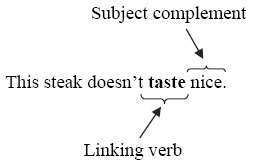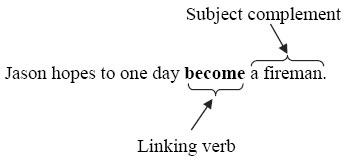Linking verbs and subject complements
Linking verbs connect the subject of a sentence with a subject complement. The subject complement is normally either a noun or an adjective that gives us some further information about the subject of the sentence. Take this sentence for example:

In this sentence, the verb ‘taste’ is what the steak ‘does’, which is why it’s a verb. However, in this sentence, the verb does not act on anything - it doesn’t have a direct object. Instead, it needs the subject complement ‘nice’ to help describe the subject of the sentence a bit more. In this case, the subject complement is an adjective, but it can also be a noun:

In this sentence the linking verb is ‘become’. Once again, it’s a verb, because it’s something that the subject (Jason) does or wants to do. He wants to ‘become’. But, it doesn’t have a direct object it acts on, instead ‘become’ is followed by a subject complement - ‘a fireman’. In this case, the subject complement is a noun.
Click here to move on to the next topic: Object complements